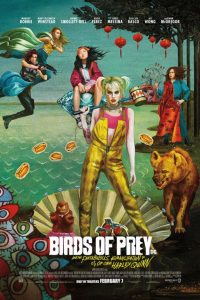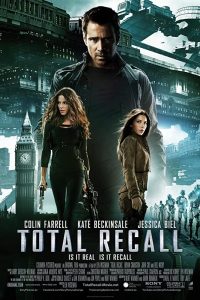Joker: Folie à Deux Movie Review by Erin Underwood
Joker: Folie à Deux starring Joaquin Phoenix and Lady Gaga follows up the 2019 smash hit Joker. The film was easily one of the most anticipated movies of 2024, which automatically puts it at a disadvantage when trying to meet the audience’s expectations. However, Joker: Folie à Deux just might be a prime example of why studios need to rethink their current approach to filmmaking when a film that should have been a slam dunk is just getting slammed.
Read Erin’s review below or watch her out-of-the-theater reaction on YouTube:
Director Todd Phillips returns to his version of Gotham’s Joker, picking up two years later in Arkham Prison as Arthur Fleck, aka Joker, goes on trial for killing 5 people while his lawyer lays the groundwork for pleading insanity. In prison, he meets Lee Quinzel, aka Harley Quinn, played by Lady Gaga, which solidifies the film’s attempt to establish itself into the DC universe. Rather than simply following the same story lines, format, and themes from the original film to turn Joker into Gotham’s iconic villain, Todd Phillips uses this film to explore the deterioration of Arthur Fleck’s mind through a musical lens.
First Impressions
While the idea behind the exploration of criminal insanity through music is fascinating, swapping out the stylistic noir format of the original for a noir musical format in Joker: Folie à Deux creates major disconnect between the two films. While the film flares with brilliant moments of possibility, it feels like the studio had a script that they loved but didn’t believe in enough to stand on its own. So they updated it to fit with the second installment of Todd Phillips’ Joker series.
Clearly, they didn’t do this, but this is what the film feels like in its finished format, solidifying the argument that the film would have either been a better fit as a standalone film disconnected from Joker and the DC universe or as a completely different Joker film that takes place in one of DC’s multiverse realities with an entirely different Joker than the one we saw in the 2019 film. As a result, Joker: Folie à Deux feels like misguided storytelling and unaligned marketing that didn’t deliver on the promise of the film, based upon the established character and the world that this sequel was meant to continue.
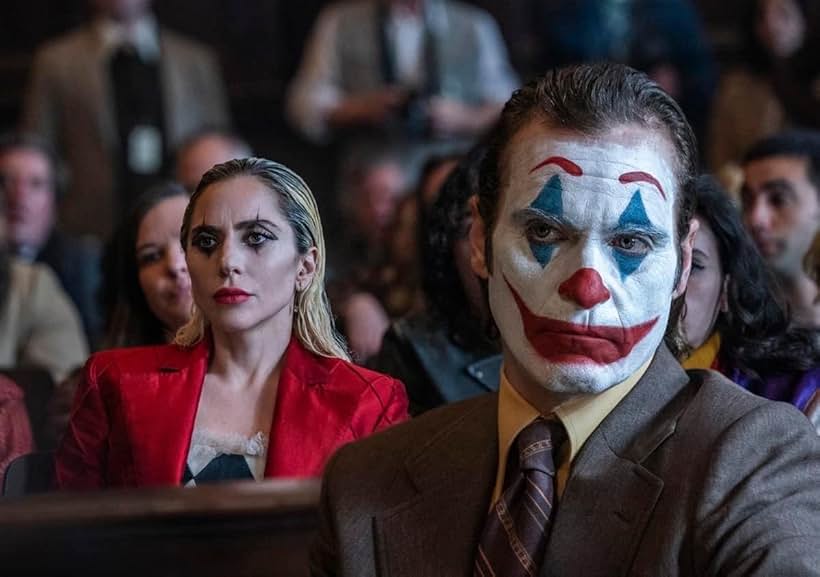
The Cast and Performances
Joaquin Phoenix as Arthur Fleck (Joker) is stellar. He brings a visceral and unsettling energy to the character as he vacillates between the fragility of Arthur Fleck and the power of Joker. His inner chaos comes through on screen when confronted by pain and emotional trauma, creating an inevitable spiral into madness. Lady Gaga as Lee Quinzel (Harley Quinn) is well cast, and her vocals were perfect for the character as she was written. Lady Gaga is captivating on screen, almost too captivating, and at times it is Lady Gaga performing on screen, not Lee Quinzel.
And the Music Played On and On and On…
While both characters are compelling, neither Phoenix nor Gaga felt like they were truly in sync with the story because the musical numbers were too numerous, often interrupting moments of character development. In addition, the musical numbers went on for far too long, turning them into music videos within the film rather than being additive moments to the story.
The finished product gives off the sense that the original script likely had light musical segments in it to act as a bridge between Arthur Fleck and his transition to Joker. However, it’s likely that casting Lady Gaga as Lee resulted in more musical segments being added and fleshed out into longer pieces, creating an imbalance between what the story could reasonably bear musically and what was delivered.
Joker: Folie à Deux and the DC Universe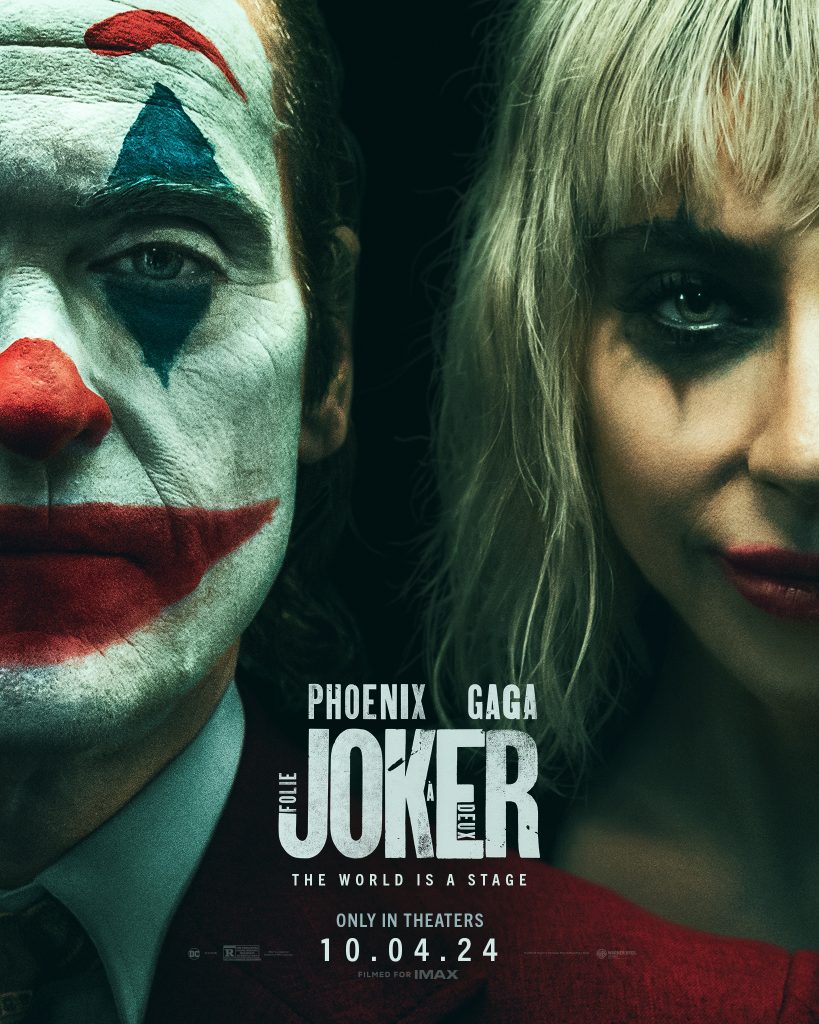
The original film Joker (2019) only seemed tangentially connected to the DC Universe, but it still delivered a powerful character in Artur Fleck (and Joker). With the addition of Lee Quinzel, DA Harvey Dent, and so many little quintessential Batman-related details, the sequel feels as if it is trying to connect itself to the DCU. And, yet it fails to deliver a DCU level Joker who is capable of standing toe to toe with The Riddler, The Penguin, or The Batman. As a result, Joker: Folie à Deux is untethered without a viable lifeline to either the film that spawned it or to the universe that inspired it.
It Could Have Been Brilliant!
Joker: Folie à Deux could have been brilliant as a film, if it weren’t tied to Joker (2019). The metaphor of music as madness is genius. The visual representation of music, diabolical fantasies, and destructive love is gorgeously conveyed as these two main characters descend into a shared madness with one struggling to hold onto his sanity and the other jumping headfirst into delusion.
The fragility of Arthur Fleck is compelling, the energy of the Joker is mesmerizing, and the struggle between the two isn’t given the friction that the film needed for their stories to be fully realized or for this film to work within the DCU. However, as a standalone film unaffiliated with any supervillain or franchise, the character of Arthur Fleck would have been a devastating portrait of humanity. Instead, he became a failed supervillain, who faded with a whimper.
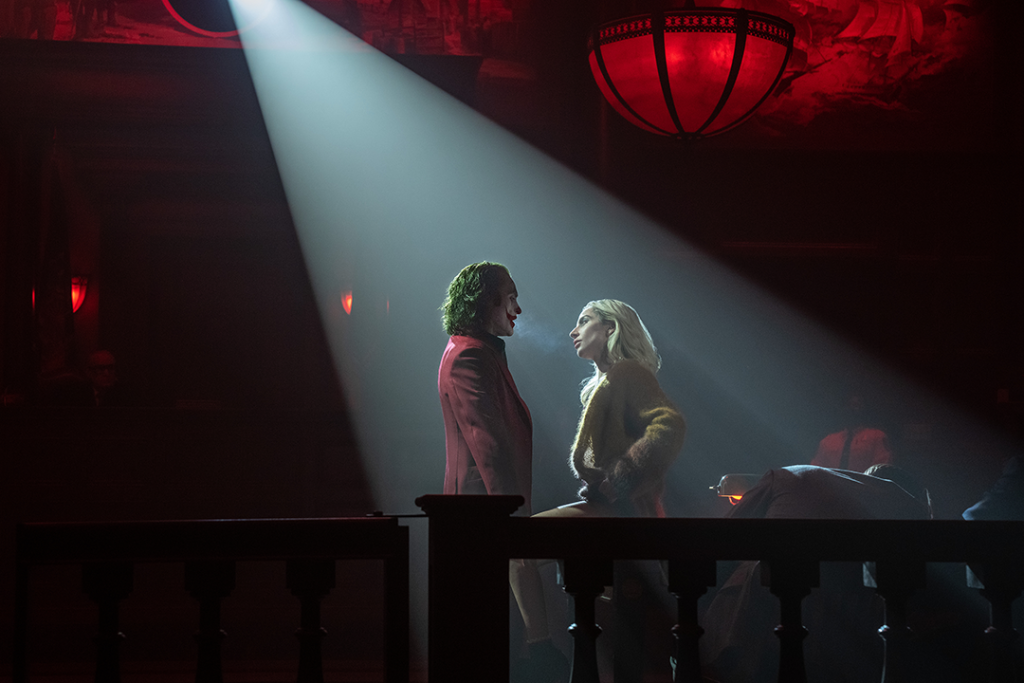
Storytelling Through the Studio’s Lens
Strangely, studios are repeating the fatal mistake of slapping on a label, a famous actor, and a franchise to a script with the expectation that this will sell the film and drive fans to lay down their hard-earned cash for a ticket. With a media-savvy audience that craves story-first entertainment, a more thoughtful approach is needed in 2024 and beyond. If Joker: Folie à Deux had been produced differently, recast, and marketed as a multiverse Joker with an artsy and provocative theme or as a non-DCU related film, it would have stood a better chance of critical success. That didn’t happen.
There should have been some kind of stop gap in the production process when a human being looked at the story being developed and compared it to the original to assess how the sequel’s storyline developed, looked at the genre swap in relation to the target audience, and imagined how the finished film would be received. It’s almost impossible to believe that this didn’t happen, but then how did we end up with Joker: Folie à Deux?
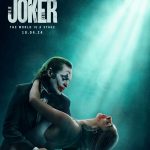 Studios Need to Understand Their Own Stories *SPOILERS*
Studios Need to Understand Their Own Stories *SPOILERS*
If the studio better understood its own story better, they would have known that Arthur Fleck/Joker wasn’t the best character fit for this narrative. Or, if they did understand this but were still determined to move forward with Joker: Folie á Deux, they would have embraced the idea of the interoperability of “The Joker” as a title that could be claimed by any of the nameless clowns and grinning madmen in the film. Or perhaps, they might have embraced Joker’s ascendence into the iconic villain or addressed why the triggers that released Joker stopped working, allowing Arthur to hold onto his sanity.
There were so many things that this film was trying to be, and by trying to be all of them simultaneously, Joker: Folie à Deux lost its center, undermining both the sequel and the original film.
Recommendation
Despite its flaws, Joker: Folie à Deux is worth seeing for one simple reason: it is starting conversations. It’s getting people to talk and to ask questions about studio responsibility, what story-first production means, and twhat the future of cinema might be, if we continue down this path. Joker: Folie à Deux may be one of the early shots across the bow as we enter the fight for good theatrical storytelling in the age of AI. For people who are going into the theater to see what everyone is talking about, keep an open mind and remember that this isn’t the Joker that the audience is expecting and maybe you will find it more enjoyable.
Directed by: Todd Phillips
Written by: Scott Silver, Todd Phillips, Bob Kane
Starring: Joaquin Phoenix, Lady Gaga, Brendan Gleeson
Erin Underwood is the senior event content producer at MIT Technology Review, curating stories around cutting-edge tech like AI, biotech, AR/VR, and climate innovations. A self-proclaimed workaholic, she fills her nights and weekends organizing sci-fi conventions (like Boston’s Boskone) and creating movie reviews. Catch her video reviews at www.youtube.com/@ErinUnderwood
 While you are here, please take a moment to support Locus with a one-time or recurring donation. We rely on reader donations to keep the magazine and site going, and would like to keep the site paywall free, but WE NEED YOUR FINANCIAL SUPPORT to continue quality coverage of the science fiction and fantasy field.
While you are here, please take a moment to support Locus with a one-time or recurring donation. We rely on reader donations to keep the magazine and site going, and would like to keep the site paywall free, but WE NEED YOUR FINANCIAL SUPPORT to continue quality coverage of the science fiction and fantasy field.
©Erin Underwood. Copyrighted material may not be republished without permission.




